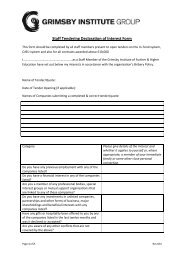Journal of Research & Scholarly Output 2006 - Grimsby Institute of ...
Journal of Research & Scholarly Output 2006 - Grimsby Institute of ...
Journal of Research & Scholarly Output 2006 - Grimsby Institute of ...
Create successful ePaper yourself
Turn your PDF publications into a flip-book with our unique Google optimized e-Paper software.
Luther did admit that representational<br />
imagery from the Bible could serve a useful<br />
teaching purpose, but it is this indifference<br />
(taken in extremis by subsequent followers –<br />
including Archbishop Cranmer et al. in<br />
England) that eradicated familiar, traditional<br />
methods <strong>of</strong> relaying passages from the<br />
Bible to the non-literate majority. Because <strong>of</strong><br />
the events <strong>of</strong> the Reformation, England<br />
crucially moved from an image-based to a<br />
text-based religious culture earlier than the<br />
rest <strong>of</strong> mainland Europe that began its<br />
Catholic recovery in Spain and particularly<br />
France, where Napoleon’s ‘concordat’ with<br />
the Holy Church <strong>of</strong> Rome brought<br />
Catholicism back as the state religion.<br />
Similarly, events in Belgium, the<br />
Netherlands, Germany and France allowed<br />
these countries a continuity <strong>of</strong> image-based<br />
narrative far stronger than ours. The fact<br />
that it remained within the confines <strong>of</strong> the<br />
Church and the introduction <strong>of</strong> the printing<br />
press for religious and non-religious works<br />
was developed in mainland Europe is not<br />
important – the majority <strong>of</strong> these European<br />
cultures were regular Church-goers, so their<br />
exposure to religious iconography<br />
continued unchallenged for a considerable<br />
time to come.<br />
While the English slowly lost their reliance<br />
on sequential art to educate and inform<br />
them, the skills required to read and<br />
understand image-based communications<br />
(in the form <strong>of</strong> single paintings or<br />
sequentially presented texts) did not<br />
completely disappear. The Reformation did<br />
not destroy our ability to understand Comic<br />
Books and this move to a text-based culture<br />
did not benefit the masses one bit, as it was<br />
not in the interests <strong>of</strong> the ruling classes to<br />
have an educated workforce. From that<br />
perspective there was very little difference<br />
to the situation maintained by the Catholic<br />
Church, but this removal <strong>of</strong> iconography did<br />
heavily influence our attitude towards<br />
imagery. The suppression <strong>of</strong> sequential<br />
visual communication by the State was one<br />
crucial aspect contributing to the unease<br />
and distrust <strong>of</strong> contemporary British<br />
readers, but this is not the whole story.<br />
There was a later development in imagebased<br />
communication, this time from a<br />
popular culture perspective, that would add<br />
the negative dimension <strong>of</strong> confusion to the<br />
English perception <strong>of</strong> comic books – the<br />
invention <strong>of</strong> the cartoon.<br />
Despite the move away from sequential<br />
works in England due to their connotations<br />
with the Catholic Church, the work <strong>of</strong><br />
William Hogarth (1697-1764) would seem to<br />
be an exception to the rule – and suggests<br />
that the visual literacy <strong>of</strong> his audience was<br />
still relatively high despite the break in<br />
continuity caused by the Reformation. His<br />
hugely popular series <strong>of</strong> engravings such as<br />
‘The Harlot’s Progress’ and ‘The Rake’s<br />
Progress’ were expressly designed to<br />
convey a narrative in a strict order, and as<br />
such illustrated the appetite for imagebased<br />
sequential entertainment in this<br />
country.<br />
‘Moll as a Prostitute’, Plate 3 <strong>of</strong> 6 from The<br />
Harlot’s Progress, William Hogarth, 1732 (c)<br />
FOCUS Page Page 77

















